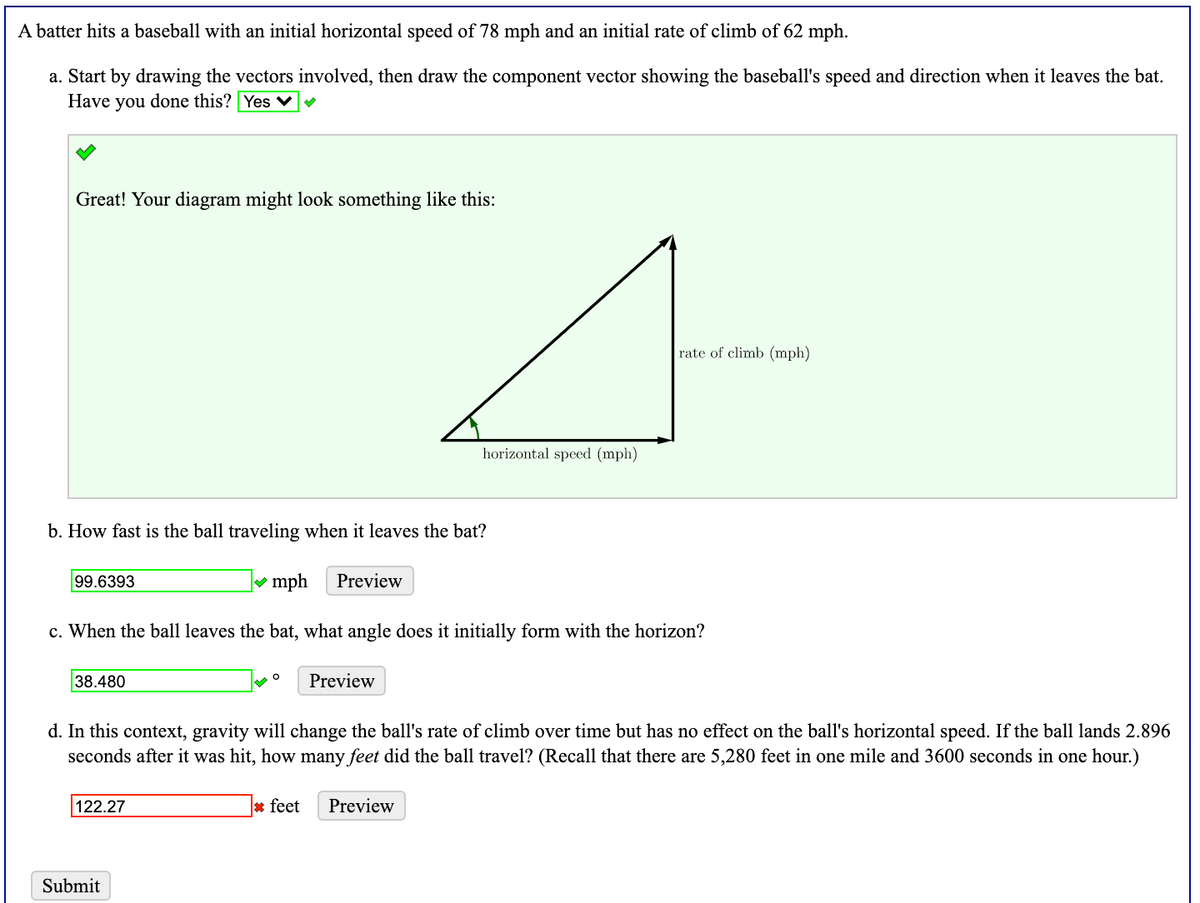n this context, gravity will change the ball's rate of climb over time but has no effect on the ball's horizontal speed. If the ball lands 2.896 seconds after it was hit, how many feet did the ball travel? (Recall that there are 5,280 feet in one mile and 3600 seconds in one hour.)
n this context, gravity will change the ball's rate of climb over time but has no effect on the ball's horizontal speed. If the ball lands 2.896 seconds after it was hit, how many feet did the ball travel? (Recall that there are 5,280 feet in one mile and 3600 seconds in one hour.)
Algebra & Trigonometry with Analytic Geometry
13th Edition
ISBN:9781133382119
Author:Swokowski
Publisher:Swokowski
Chapter8: Applications Of Trigonometry
Section8.4: The Dot Product
Problem 48E
Related questions
Question
In this context, gravity will change the ball's rate of climb over time but has no effect on the ball's horizontal speed. If the ball lands 2.896 seconds after it was hit, how many feet did the ball travel? (Recall that there are 5,280 feet in one mile and 3600 seconds in one hour.)

Transcribed Image Text:A batter hits a baseball with an initial horizontal speed of 78 mph and an initial rate of climb of 62 mph.
a. Start by drawing the vectors involved, then draw the component vector showing the baseball's speed and direction when it leaves the bat.
Have you done this? Yes
Great! Your diagram might look something like this:
rate of climb (mph)
horizontal speed (mph)
b. How fast is the ball traveling when it leaves the bat?
99.6393
v mph
Preview
c. When the ball leaves the bat, what angle does it initially form with the horizon?
38.480
Preview
d. In this context, gravity will change the ball's rate of climb over time but has no effect on the ball's horizontal speed. If the ball lands 2.896
seconds after it was hit, how many feet did the ball travel? (Recall that there are 5,280 feet in one mile and 3600 seconds in one hour.)
122.27
* feet
Preview
Submit
Expert Solution
This question has been solved!
Explore an expertly crafted, step-by-step solution for a thorough understanding of key concepts.
This is a popular solution!
Trending now
This is a popular solution!
Step by step
Solved in 2 steps

Knowledge Booster
Learn more about
Need a deep-dive on the concept behind this application? Look no further. Learn more about this topic, calculus and related others by exploring similar questions and additional content below.Recommended textbooks for you

Algebra & Trigonometry with Analytic Geometry
Algebra
ISBN:
9781133382119
Author:
Swokowski
Publisher:
Cengage

Linear Algebra: A Modern Introduction
Algebra
ISBN:
9781285463247
Author:
David Poole
Publisher:
Cengage Learning

Trigonometry (MindTap Course List)
Trigonometry
ISBN:
9781337278461
Author:
Ron Larson
Publisher:
Cengage Learning

Algebra & Trigonometry with Analytic Geometry
Algebra
ISBN:
9781133382119
Author:
Swokowski
Publisher:
Cengage

Linear Algebra: A Modern Introduction
Algebra
ISBN:
9781285463247
Author:
David Poole
Publisher:
Cengage Learning

Trigonometry (MindTap Course List)
Trigonometry
ISBN:
9781337278461
Author:
Ron Larson
Publisher:
Cengage Learning